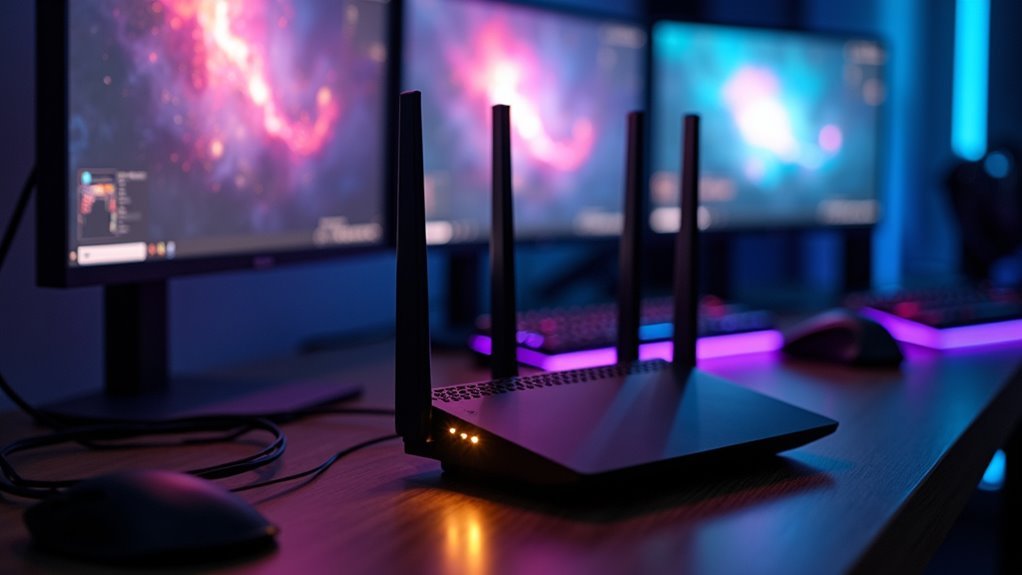You’ve probably experienced that frustrating moment when your game starts lagging right as you’re about to secure a victory, or when your connection drops entirely during a vital online match. While you might blame your internet provider or the game servers, there’s often a more fundamental issue at play: your home network’s ability to deliver consistent, reliable connectivity exactly where and when you need it most.
Understanding Mesh WiFi Technology for Gaming

When you’re gaming in a larger home, traditional single routers often create frustrating dead zones that can ruin your experience.
But mesh WiFi technology solves this problem by deploying multiple interconnected nodes throughout your space. These nodes work together to eliminate coverage gaps and provide seamless connectivity throughout your entire home.
The proper placement of mesh nodes guarantees you’ll always connect to the nearest access point, which helps reduce lag during intense gaming sessions.
Unlike traditional routers that struggle with multiple devices competing for bandwidth, mesh systems excel at managing numerous connected gadgets simultaneously.
This capability maintains consistent speeds across your network, preventing the frustrating slowdowns that occur when family members stream videos or browse the internet while you’re gaming.
How Mesh Networks Distribute Gaming Traffic
Since mesh networks operate through intelligent traffic distribution, your gaming data travels through the most efficient pathways available across multiple nodes.
Each node communicates with others, creating redundant routes that minimize latency and reduce packet loss during intense gaming sessions. When you’re playing online, the system automatically selects the best path for your gaming traffic, avoiding congested routes that could cause lag.
Smart node communication creates backup pathways that automatically dodge network congestion, delivering lag-free gaming performance when you need it most.
Multiple nodes work together to balance your connection load, ensuring you maintain a stable connection even when other devices compete for bandwidth.
This distributed approach means if one pathway becomes overwhelmed, your gaming data seamlessly reroutes through alternative nodes. The result is consistent performance that adapts to real-time network conditions, giving you the reliable connectivity essential for competitive gaming.
Latency Considerations in Mesh WiFi Systems

While mesh networks excel at routing your gaming traffic efficiently, the speed at which that data travels between nodes directly impacts your gaming performance.
Multiple hops between mesh systems can introduce additional latency compared to traditional routers, creating potential delays during competitive gaming sessions.
Your node placement strategy becomes essential here. When you position nodes too far apart, signals travel longer distances, increasing lag times. Interference from household devices on similar frequencies compounds this issue.
Shared bandwidth across multiple connected devices can spike latency, especially during peak usage periods. That’s where Quality of Service (QoS) settings prove invaluable, prioritizing your gaming traffic over other network activities.
Consider implementing Ethernet backhaul connections between nodes. This wired approach eliminates wireless transmission delays, greatly reducing latency for ideal placement throughout your home.
Coverage Benefits for Multi-Room Gaming Setups
As gaming setups expand beyond single rooms, mesh WiFi systems deliver unmatched coverage that traditional routers can’t match.
You’ll eliminate WiFi dead zones throughout your home while maintaining strong signals for all your gaming devices, regardless of location.
With coverage exceeding 3,000 sq. ft. per node, you can game confidently in any room. The seamless handoff between nodes guarantees you won’t experience connection drops when moving between areas.
Mesh WiFi nodes deliver seamless gaming coverage across 3,000+ square feet, eliminating connection drops as you move between rooms.
Key coverage advantages include:
- Strong signal strength reaches basement gaming caves and upstairs bedrooms equally
- Multiple connected devices maintain ideal performance without bandwidth competition
- Consistent speeds across all rooms prevent frustrating lag spikes during critical moments
- Automatic node switching keeps your connection stable as you move throughout your home
This extensive coverage transforms your entire house into a gaming-ready environment.
Bandwidth Management Across Multiple Gaming Devices

When multiple gamers compete for bandwidth in your household, mesh WiFi systems excel at intelligent traffic management that keeps everyone’s connection running smoothly.
These systems create multiple data pathways that reduce packet loss and maintain consistent speeds across all your gaming devices. Through smart bandwidth management, mesh networks prioritize high-demand gaming traffic while preventing other household devices from causing disruptions.
The ability to handle multiple connections simultaneously means several gamers can play online without experiencing significant latency issues.
Strategic placement of mesh nodes guarantees you’ll connect to the nearest access point for peak signal strength and reduced lag.
However, remember that mesh WiFi enhances your existing internet speed rather than increasing it, so you’ll still need a robust plan for peak performance.
Dead Zone Elimination and Gaming Connectivity
Dead zones transform from gaming nightmares into distant memories once you deploy a mesh WiFi system throughout your home.
Each node communicates directly with your gaming devices and other nodes, delivering ideal signal strength wherever you’re playing. Unlike traditional extenders that degrade performance, mesh networks distribute WiFi coverage evenly throughout large spaces.
Your gaming connectivity benefits from strategic node placement, as devices automatically connect to the nearest access point. This reduces latency and prevents those frustrating mid-game disconnections that plague traditional routers.
Strategic node placement ensures your gaming devices automatically connect to the strongest signal, eliminating latency spikes and mid-game disconnections.
- Multiple nodes eliminate dead zones by creating overlapping coverage areas
- Direct device-to-node communication maintains consistent signal strength
- Seamless handoffs between nodes prevent gaming interruptions
- Ideal placement reduces latency for improved gaming performance
Node Placement Strategies for Optimal Gaming Performance
You’ll achieve the best gaming performance by positioning your mesh nodes strategically throughout your home, focusing on areas where you actually game.
Place nodes within direct line of sight when possible and keep them no more than two rooms apart to maintain strong signal strength.
Smart positioning directly impacts your gaming latency, so you’ll want to avoid placing nodes near interference-causing devices like microwaves or cordless phones.
Strategic Node Positioning
While many gamers focus solely on internet speed when setting up their mesh networks, strategic node positioning can make the difference between seamless gameplay and frustrating lag spikes.
You’ll want to create ideal coverage that directly serves your gaming devices while maintaining strong signal strength throughout your space.
- Position nodes in a triangular configuration to maximize coverage and guarantee each node communicates effectively with others.
- Place at least one node close to your primary gaming area to minimize latency for competitive online games.
- Avoid walls, metal objects, and electronic devices that create interference and weaken signal transmission.
- Test network speed regularly using tools like SpeedTest.net to identify weak coverage spots and adjust positioning.
Strategic node positioning transforms your mesh network from basic connectivity into a gaming-ideal powerhouse.
Minimizing Gaming Latency
Smart node placement goes beyond coverage—it directly impacts your gaming latency and can determine whether you dominate online matches or suffer through lag-induced defeats.
Position nodes strategically between your main router and gaming setup, maintaining strong connections to both endpoints. Connect your gaming device to the nearest node while guaranteeing minimal obstacles degrade signal quality.
Keep nodes away from interference sources like microwaves and cordless phones that disrupt WiFi signals during vital gaming moments.
If your mesh network supports Ethernet backhaul, use it—this creates a dedicated backbone between nodes, delivering superior stability and speed for gaming traffic.
Monitor your connection performance regularly and relocate nodes when necessary. Network conditions change, and proactive adjustments guarantee your mesh network consistently delivers the low-latency gaming experience you need.
Quality of Service Features in Mesh Networks
Although traditional routers treat all internet traffic equally, Quality of Service (QoS) features in mesh networks revolutionize gaming by intelligently prioritizing your bandwidth allocation.
These systems guarantee your gaming traffic receives higher priority over less critical activities like browsing or streaming, dramatically reducing latency during vital gameplay moments.
You can customize QoS settings to designate your gaming console or PC as high priority, minimizing interruptions across multiple connected devices.
This optimization reduces packet loss and improves network traffic flow throughout your home.
Advanced mesh systems offer these QoS benefits:
- Automatic gaming device detection and performance adjustment
- Manual priority settings for specific devices or applications
- Real-time network traffic optimization across all nodes
- Significant ping time improvements for competitive gaming
Effective QoS implementation delivers noticeable responsiveness improvements, making it indispensable for serious gamers.
Comparing Mesh WiFi to Traditional Gaming Routers
Gaming routers and mesh WiFi systems represent fundamentally different approaches to network optimization, each engineered with distinct priorities that directly impact your gaming performance.
Gaming routers concentrate on delivering ultra-low latency and high-speed processing for your internet connection, featuring sophisticated Quality of Service (QoS) settings that let you customize bandwidth allocation specifically for gaming traffic.
However, they’re limited by single-device connectivity and restricted coverage range.
Conversely, a mesh WiFi network excels at eliminating dead zones through multiple nodes, providing extensive coverage throughout your home.
You’ll benefit from superior support for multiple devices connected simultaneously, making mesh systems ideal for households with several gamers.
However, mesh systems may introduce latency issues and typically lack the advanced traffic prioritization features that dedicated gaming routers offer.
Impact of WiFi 6 and WiFi 6E on Gaming Performance
You’ll experience dramatically better gaming performance when your mesh system supports WiFi 6 or WiFi 6E technology.
These newer standards deliver faster speeds, lower latency, and more efficient bandwidth management that directly translate to smoother gameplay.
The advanced features like OFDMA and the additional 6 GHz band in WiFi 6E create ideal conditions for competitive gaming where every millisecond matters.
WiFi 6E Gaming Benefits
How does upgrading to WiFi 6E transform your gaming sessions from frustrating lag-fests into seamless competitive experiences?
WiFi 6E delivers game-changing benefits that serious gamers can’t ignore. You’ll experience reduced latency through advanced OFDMA technology, guaranteeing your shots register instantly in competitive matches. The 6 GHz band eliminates congestion, so multiple devices won’t throttle your connection during vital moments.
WiFi 6E gaming benefits include:
- Ultra-low latency – OFDMA and MU-MIMO technologies minimize packet loss for real-time responsiveness
- Massive throughput – Up to 9.6 Gbps supports 4K gaming and VR without performance drops
- Superior device management – Handle numerous smart home devices without impacting online gaming performance
- Enhanced security – WPA3 protocols protect against cyber threats during multiplayer sessions
Modern gaming routers with WiFi 6E guarantee you’re equipped for today’s demanding gaming landscape.
Latency and Speed Improvements
Behind these WiFi 6E advantages lies a fundamental transformation in how your network handles gaming data.
WiFi 6 introduces OFDMA technology, allowing multiple devices to transmit simultaneously rather than taking turns. This dramatically reduces latency during gaming sessions, especially when family members stream videos or download files.
Your gaming routers equipped with WiFi 6 deliver faster speed through improved data processing and beamforming technology.
These advancements minimize packet loss and strengthen signal reliability. Meanwhile, enhanced Quality of Service (QoS) features automatically prioritize your gaming traffic over less time-sensitive activities.
When integrated into mesh WiFi systems, these improvements become even more powerful.
You’ll experience consistent low latency throughout your home, eliminating dead zones that previously caused lag spikes during essential gaming moments.
Managing Network Congestion in Gaming Households
When multiple devices compete for bandwidth in your gaming household, network congestion becomes the silent enemy of smooth gameplay.
Managing network congestion requires strategic action to guarantee your gaming sessions aren’t interrupted by other devices streaming, downloading, or updating.
To prioritize gaming traffic effectively, you’ll need to configure Quality of Service (QoS) settings on your mesh network. This guarantees your gaming device receives dedicated bandwidth even when multiple connected devices are active.
Consider these optimization strategies:
- Disconnect unnecessary devices during intense gaming sessions to reduce network strain
- Use an Ethernet connection for your primary gaming device to minimize latency
- Monitor bandwidth usage regularly to identify devices consuming excessive resources
- Schedule automatic updates for non-gaming devices during off-peak gaming hours
Ethernet Backhaul Options for Competitive Gaming
When you’re serious about competitive gaming, Ethernet backhaul transforms your mesh network from good to exceptional by creating dedicated wired connections between nodes.
You’ll experience dramatically reduced latency and improved stability compared to wireless-only mesh systems, giving you the edge needed for split-second gaming decisions.
Setting up wired backhaul requires strategic planning and proper configuration, but the performance gains make it essential for any gaming household that demands consistent, low-latency connections.
Wired Backhaul Performance Benefits
Although wireless connections between mesh nodes offer convenience, connecting your mesh system’s nodes via Ethernet cable delivers considerably better performance for competitive gaming.
When you implement wired backhaul, you’ll experience notably reduced latency and enhanced data transmission speeds that wireless connections simply can’t match.
Your gaming experience improves dramatically because each node maintains a dedicated, stable connection to your main router. This setup eliminates the interference that typically affects wireless connections, ensuring consistent performance during intense gaming sessions.
Key benefits of wired backhaul include:
- Minimized packet loss through dedicated bandwidth allocation
- Reduced network congestion by freeing wireless bandwidth for other devices
- Lower ping times essential for real-time competitive gaming
- Enhanced stability during high-usage periods
Setup and Configuration
Setting up Ethernet backhaul for your mesh system requires careful planning of cable routes and strategic node placement throughout your home.
You’ll need to run Ethernet cables from your main router to each mesh node, which might involve drilling holes or using existing cable pathways.
During the setup process, access your router’s configuration interface to enable wired backhaul mode and disable wireless backhaul between nodes.
Most mesh WiFi systems automatically detect Ethernet connections and prioritize them over wireless links.
This configuration greatly reduces packet loss by creating dedicated data highways for your gaming traffic.
The result is ideal performance with lower latency and improved stability.
While the initial setup requires effort, your gaming performance will benefit considerably from this reliable backbone connection.
Latency Reduction Techniques
Since competitive gaming demands split-second reactions, you’ll want to maximize your mesh system’s potential through dedicated Ethernet backhaul connections.
This setup transforms your wireless mesh system by creating wired links between nodes, dramatically reducing latency and eliminating the signal degradation that wireless connections often experience.
Ethernet backhaul provides several advantages for gaming performance:
- Dedicated bandwidth between mesh nodes prevents wireless interference and maintains consistent speeds
- Reduced packet loss during intense gaming sessions through stable, high-speed internet connections
- Prioritized gaming traffic with minimal network congestion between access points
- Enhanced reliability that supports Gigabit+ internet plans for maximum performance potential
While installation requires additional effort, the resulting latency improvements and network stability make Ethernet backhaul essential for serious competitive gamers.
Troubleshooting Common Mesh WiFi Gaming Issues
When gaming performance suffers on your mesh WiFi network, you’ll need to systematically identify and resolve the underlying issues affecting your connection.
Start by optimizing node placement to minimize latency and maximize signal strength throughout your gaming area. Check for interference from household devices operating on the same frequency, as they can introduce lag and connectivity issues.
Monitor your network load and disconnect unnecessary connected devices that strain bandwidth during gaming sessions. If available, utilize Ethernet backhaul to enhance connections between nodes for improved stability.
Conduct regular speed tests to verify you’re receiving expected speeds from your ISP. Contact your provider if speeds consistently fall short, indicating potential connectivity problems requiring professional resolution.
Optimizing Mesh Settings for Different Gaming Scenarios
Beyond resolving basic connectivity problems, you’ll want to fine-tune your mesh network’s configuration to match your specific gaming habits and requirements.
Different gaming scenarios demand tailored approaches to enhance your mesh WiFi performance and minimize latency issues.
- Position nodes strategically near your gaming devices to maintain strong signal strength and reduce connection drops during critical gameplay moments.
- Configure Quality of Service (QoS) settings to prioritize gaming traffic over other household activities like streaming or file downloads.
- Utilize the 5 GHz band for gaming devices to access faster speeds and lower latency, while reserving 2.4 GHz for smart home devices.
- Manage bandwidth allocation by disconnecting non-essential devices during intensive gaming sessions to maximize available network resources for peak performance.
Frequently Asked Questions
Is a Mesh Wifi System Good for Gaming?
Yes, you’ll benefit from mesh WiFi’s extensive coverage and reduced packet loss in large homes. However, you’ll need proper node placement and a fast internet plan to avoid potential latency issues during gaming.
What Is the Disadvantage of Mesh Wifi?
You’ll experience increased latency through multiple nodes, shared bandwidth reducing speeds during peak usage, potential interference from household devices, and weaker signals at network edges compared to direct connections.
Does Mesh Wifi Cause Lag?
Mesh WiFi can cause lag if you don’t optimize node placement or experience interference. You’ll notice signal strength varies by distance, and sharing bandwidth across multiple devices may increase latency during gaming.
Why Is My Wifi so Bad for Gaming?
Your gaming suffers because you’re sharing bandwidth with multiple devices, experiencing signal interference from household electronics, dealing with higher latency than wired connections, and potentially having suboptimal router placement affecting signal strength.





Leave a Reply